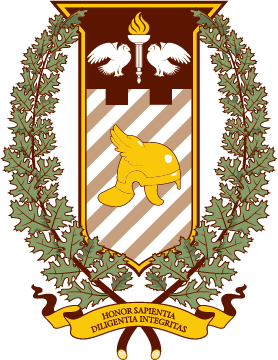Traditions and Symbols
Traditions and Symbols
ACADEMIC REGALIA & PAGEANTRY
The pageantry of Commencement includes academic protocol and traditional costume, as well as symbolic elements of the procession and ceremony. Administrative and academic officers and participants carry and wear various ceremonial regalia.
THE MACE
Originally used as a weapon, the mace has become an ornamental symbol of authority borne by a public official at ceremonies. At Rowan, the University Mace is carried by the senior faculty member acting as grand marshal in the Commencement procession. The mold for the mace was made by the University Art Department. A gift of the Alumni Association, the mace was cast of solid silver by William C. Martin Jewelers in Philadelphia.
THE MEDALLION
The Presidential Medallion was struck with a die of the University seal. It symbolizes the office of the presidency. Ornamental plates interspersed on the chain depict griffin-like owls as a symbol of the pedagogical heritage of the University. Other plates are engraved with the names and years of service of the previous presidents, Jerohn J. Savitz, Edgar F. Bunce, Thomas E. Robinson, Mark M. Chamberlain, Herman D. James and Donald J. Farish. The president wears the medallion during official ceremonies.
ACADEMIC COSTUME
The wearing of academic gowns is a tradition that dates back to the early 14th century. The gowns were first used to distinguish scholars from regular citizens. The added advantage of the garments was to keep the medieval academics warm in the unheated buildings they used. Their practical purposes soon gave way to embellishments and the gowns became a means of identifying certain academic achievements.
THE GONFALONS
Among the most visible elements of academic pageantry are the gonfalons, which represent each of the colleges and schools in the University. Acting as the college or school marshal, the senior member of the faculty in each division bears the gonfalon in Commencement and Convocation processions.
All Rowan gonfalons have in common several elements that symbolize the unified mission of the institution’s colleges and schools. Among the common elements are the school colors, brown and gold, derived from the Brown-eyed Susans that grew wild in the orchard that was part of the original Whitney estate where the main campus now is situated. Also in common is the oak swag, inspired by the stately oaks that shade the Glassboro campus and symbolize long life, strength and endurance. Within the shield, the owls suggest the pedagogical heritage of the University. According to heraldic code, their posture—shown in profile with inverted, addorsed wings and with both feet on the ground—suggests a collegial relationship, positive demeanor, readiness and intent to rise with purpose. Following the pattern of the University seal engraving, beneath each college shield is a motto in Latin, the classic international language of scholarship and thought.
Within the shield on each gonfalon is imagery specific to each college and school. Rowan student and alumni artists created the art after extensive research. Commissioned to design banners that would efficiently represent the many diverse disciplines and philosophies of study in the colleges and schools, the University’s illustration and design team turned to traditional symbols, mythology and metaphors to create historically meaningful imagery that would be relevant today and in the future.
WILLIAM G. ROHRER COLLEGE OF BUSINESS
The art depicted for the Rohrer College of Business is derived from Greek and Roman mythology: the helmet of Hermes or Mercury, the god of trade, profit and commerce. In both mythological traditions, the god was associated with commerce in general, invention, travel and boundaries, and weights and measures, all appropriate for discussion of the international scope of business in its various specialties as studied at Rowan’s Rohrer College of Business. The College motto is “Honor, wisdom, industry and integrity.”
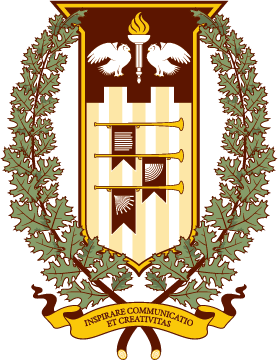
RIC EDELMAN COLLEGE OF COMMUNICATION & CREATIVE ARTS
The trumpets and pennants on the College of Communication & Creative Arts gonfalon symbolize medieval methods of communication and identification. Trumpet blasts were a means by which encampments and kingdoms exchanged messages across long distances. The pennants, used in pageantry and on a variety of structures, artistically expressed the identities and qualities of the bearers. As crucial aspects of our humanity, communication and creativity are foundations of varied academic areas and are enacted in the aural, verbal and visual channels illustrated on the pennants. The College motto is “Inspiring communication and creativity.”
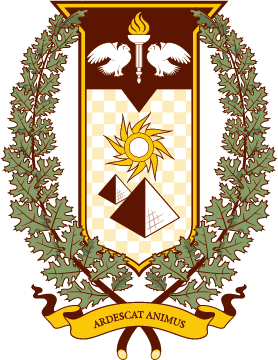
HENRY M. ROWAN COLLEGE OF ENGINEERING
Icons of engineering wonder and ingenuity, the two pyramids on the gonfalon are meant to symbolize the original elements and principles employed by the ancients. The sun suggests energy as well as the continual enlightenment and opportunity that come as a result of exploration, problem solving and discovery through application of engineering disciplines. The College of Engineering is the legacy of Henry M. Rowan, the benefactor of the University who made possible engineering education at the insitution. Inspired by Mr. Rowan’s life and the name of his autobiography, the motto of the College speaks of his passion for ingenuity and purpose and kindling that passion in others. Translated, the motto is “Building the fire within.”
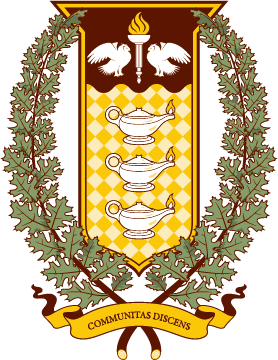
COLLEGE OF EDUCATION
A traditional symbol of enlightenment, the lamp’s rendering on the gonfalon is a classical form that existed with little change into the 19th century. Its practical uses for shedding light or preserving a flame to ignite others make the ancient device appropriate as a contemporary symbol of education’s best purposes. The use of three lamps on the gonfalon suggest the three levels studied at Rowan: elementary, secondary and higher education. The repetition of the art also signifies the pedagogical fundamentals inherent in each course of study that link them together and build upon one another in the College of Education. The motto of the College is “The learning community.”
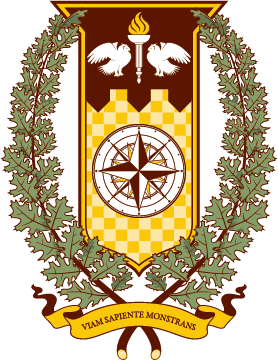
COLLEGE OF HUMANITIES & SOCIAL SCIENCES
The compass has been used as a navigational tool since the 11th century. By choosing the compass as its icon, the College of Humanities & Social Sciences acknowledges that its disciplines provide students with the knowledge, attitudes, ethics and global outlook necessary for navigating successfully through life and exploring the paths presented by dynamic career and life circumstances. Building a solid foundation within the liberal arts allows students to seek individualized answers to an essential question: “Where am I going?” The College motto is “Leading the way to wisdom.”
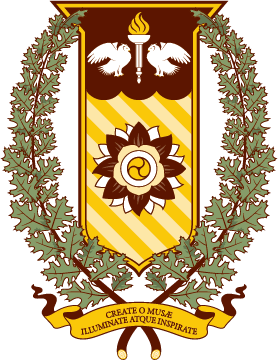
COLLEGE OF PERFORMING ARTS
The Performing Arts gonfalon contains a composite illustration inspired by principles applicable to all performing arts and those who create and interpret artistic expression. At the center of the art is a Celtic symbol suggesting creative replenishment and new life. Outside the world triad is the lotus flower, a symbol of creation in Greek and Eastern cultures. Blended together, these symbolize the best intent of performing artists expressing a vision or giving voice to a thought. The art also employs the Fibonacci sequence that produces a balanced and pleasing effect. Translated, the College of Performing Arts motto is “O Muse, create, illuminate, inspire!”
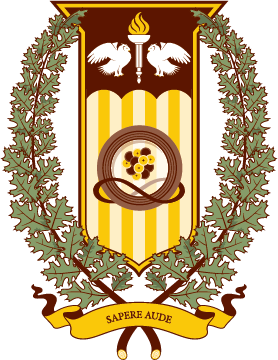
COLLEGE OF SCIENCE & MATHEMATICS
The disciplines in the College of Science & Mathematics stem from the Age of Enlightenment, the era in which modern science, universal education and the questioning of traditional forms of authority emerged. In 1784, Immanuel Kant wrote the classic response to the question, “What is the Enlightenment?” He said, “The Enlightenment is man’s emergence from his self-incurred immaturity.” The motto of the Enlightenment according to Kant was “Sapere aude!”—“Dare to be wise!” or “Dare to know!” It is the charge for College of Science & Mathematics students and faculty to use reason and intellect for self-liberation through pursuit of knowledge and truth.
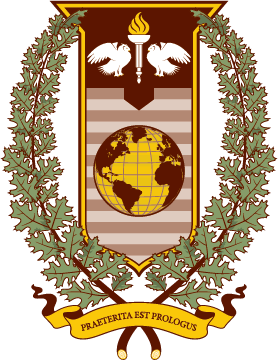
SCHOOL OF EARTH & ENVIRONMENT
The elements that distinguish the School of Earth & Environment crest begin with the solid brown field at the top of the shield that descends into the shape of a spade, a basic tool of discovery in earth sciences. The striped field symbolizes the earth’s strata, each layer offering insight on the planet’s past, present and future. The globe illustration is situated on the crest to show the eastern U.S., where the world’s first nearly complete skeleton was found, as well as Argentina and Egypt, the sites of major dinosaur discoveries. The School’s motto, “Praeterita est prologus,” is drawn from Shakespeare, commentary applicable to all of life and this planet’s place in the universe: “What’s past is prologue.”
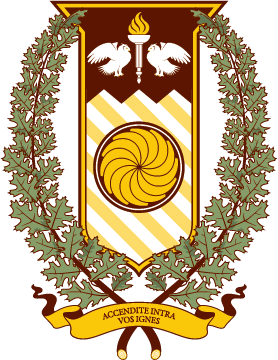
SCHOOL OF INNOVATION & ENTREPRENEURSHIP
Entrepreneurship requires action—typically, a cycle of ideation, discovery, innovation, testing, failure, correction and back to the start repeatedly—before success. The wheel of perpetual motion illustrated in the School of Innovation & Entrepreneurship crest portrays the concept first documented in seventh century India by Bhaskara and later explored by da Vinci, Villard de Honnecourt, Kircher and others. Rowan’s approach to entrepreneurship education reinforces the idea that entrepreneurship is an act of creation that defies disciplinary boundaries and follows the evolution of the wheel: pursuit of an ideal, learning from failure and iterating to a viable solution. Those with passion and perseverance find and beget success, perpetuating opportunity and progress for themselves and others. The School’s motto, “Ignite your fire!” issues both challenge and encouragement to students and faculty, kindling a spirit of innovation and ambition.
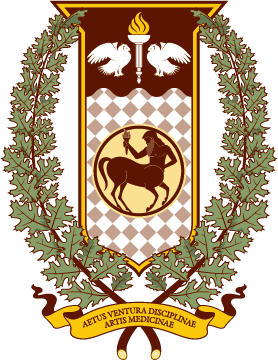
COOPER MEDICAL SCHOOL
Drawing on Greek mythology, the Medical School gonfalon depicts Chiron, the esteemed centaur known for his great intellect and skill in medicine. Chiron taught many Greek gods and heroes, including Asclepius, the god of medicine mentioned in the ancient Hippocratic oath sworn by physicians. A symbol of enlightenment and life, his fiery torch suggests Chiron’s self-sacrifice to allow mankind the use of fire. The illustration alludes to the science and art of medical education: a legacy of great skill, tender care and professional expertise conveyed from teacher to student to benefit humanity. The School's motto is “The next generation of medical education.”
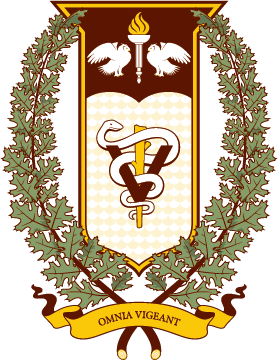
SHREIBER SCHOOL OF VETERINARY MEDICINE
Following the custom of its discipline, the School of Veterinary Medicine displays a caduceus, the imagery most well-known as a symbol of health care, and adds the V to distinguish veterinary medicine. With its commitment to the concept of “one medicine” supporting “one health,” the School embraces the practice of a comprehensive approach to life that considers and honors all creatures and the planet we share. The field behind the caduceus is inspired by imagery of overlapping feathers and scales to represent living things in the air, water and land. The School's motto is Omnia vigeant, “Let all things be healthy and thrive.”
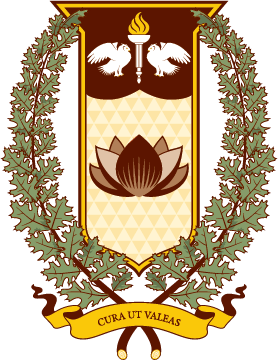
VIRTUA HEALTH COLLEGE OF MEDICINE & LIFE SCIENCES
The partnership between Virtua Health and Rowan University established a framework for the two institutions to share and expand on their commitment to improve the health of New Jersey residents through the state’s next generations of physicians, nurses, health educators and health professionals. The stylized lotus flower in the college crest echoes imagery that represents the Virtua Health community and, by extension, Rowan University medical and health professions education. The symbolic lotus—from deep roots to graceful, layered petals—is known for adaptability, regeneration and usefulness for health and healing. A typical Latin greeting for people they cared about, the college motto derives from a shared mission in health care and education for people to “Be well, stay well.”
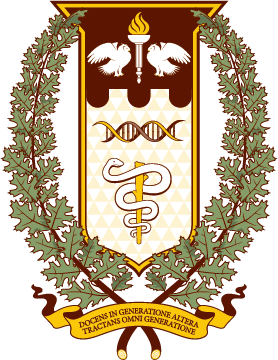
ROWAN-VIRTUA SCHOOL OF OSTEOPATHIC MEDICINE
The School of Osteopathic Medicine gonfalon contains images that represent the school’s mission to provide excellence in medical education, research and health care for New Jersey and the nation. The Rod of Asclepius, a staff encircled by a snake, evokes the traditional symbol of the Greek god of medicine revered for his power to heal. The DNA helix acknowledges the molecular basis of all being as examined by SOM students, researchers and physicians. Combined, the two symbols indicate the school’s commitment to serve and lead as professionals inspired and informed by SOM’s rich research heritage in social, behavioral, clinical and basic sciences. The SOM motto is “Teaching the next generation, treating every generation.”
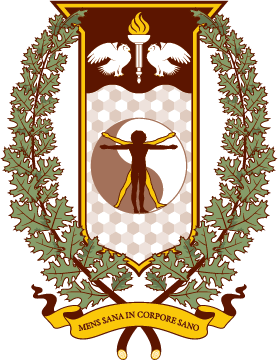
ROWAN-VIRTUA RITA & LARRY SALVA SCHOOL OF NURSING & HEALTH PROFESSIONS
Inspired by da Vinci’s iconic Vitruvian Man, the figure at the center of the gonfalon suggests the school’s focus on the study of and benefit to human health, both the collective whole and individuals, encompassing and engaging both mind and body. The yin-yang symbol underlies the human figure to emphasize the school’s foundation in balanced, holistic health, while the background field’s hexagonal tessellation is based on depictions of molecular structures that symbolize the foundation of life. The school’s motto is derived from ancient Roman poet Juvenal’s Latin verse, “Mens sana in corpore sano,” which translates to “A sound mind in a sound body.”
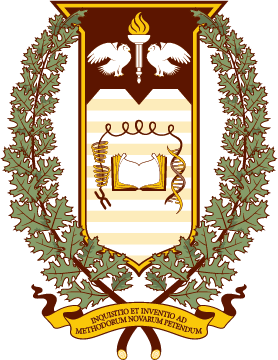
ROWAN-VIRTUA GRADUATE SCHOOL OF BIOMEDICAL SCIENCES
Inspired by the idea of unraveling the mysteries of life sciences, the art on the gonfalon for the Graduate School of Biomedical Sciences depicts the study of the entire genome as illustrated by the chromosome and the DNA double helix. The book reminds the observer of the goal described in the school’s mission statement: to develop scientists who will contribute new knowledge in the biomedical disciplines through creative research and scholarship. As they unravel complexities in the biomedical sciences through experimentation and analysis, scholars and researchers illustrate the methods and results of their work as described in the GSBS motto, “Research and discovery for the purpose of innovation.”
